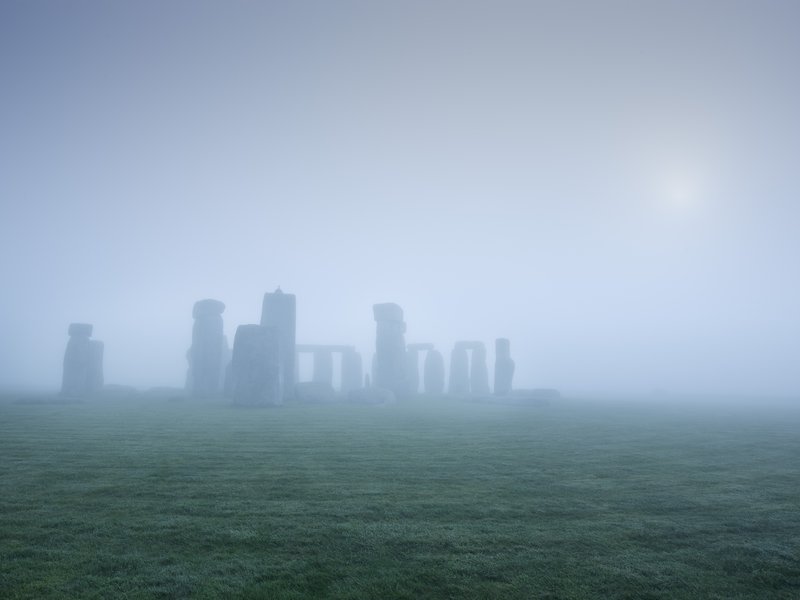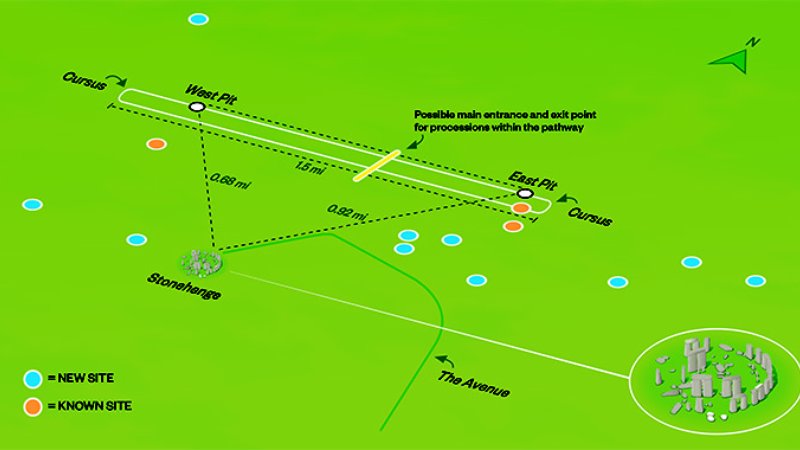We walked the Avenue, the ancient route along which the stones were first dragged from the River Avon. For centuries, this was the formal path to the great henge, but now the only hint of its existence was an indentation or two in the tall grass. It was a fine English summer’s day, with thin, fast clouds above, and as we passed through fields dotted with buttercups and daisies, cows and sheep, we could have been hikers anywhere, were it not for the ghostly monument in the near distance.
Stonehenge-A New Understanding: Solving the Mysteries of the Greatest Stone Age Monument

Faint as the Avenue was, Vince Gaffney hustled along as if it were illuminated by runway lights. A short, sprightly archaeologist of 56, from Newcastle upon Tyne in northeast England, he knows this landscape as well as anyone alive: has walked it, breathed it, studied it for uncounted hours. He has not lost his sense of wonder. Stopping to fix the monument in his eyeline, and reaching out toward the stones on the horizon, he said, “Look, it becomes cathedralesque.”
Gaffney’s latest research effort, the Stonehenge Hidden Landscapes Project, is a four-year collaboration between a British team and the Ludwig Boltzmann Institute for Archaeological Prospection and Virtual Archaeology in Austria that has produced the first detailed underground survey of the area surrounding Stonehenge, totaling more than four square miles. The results are astonishing. The researchers have found buried evidence of more than 15 previously unknown or poorly understood late Neolithic monuments: henges, barrows, segmented ditches, pits. To Gaffney, these findings suggest a scale of activity around Stonehenge far beyond what was previously suspected. “There was sort of this idea that Stonehenge sat in the middle and around it was effectively an area where people were probably excluded,” Gaffney told me, “a ring of the dead around a special area—to which few people might ever have been admitted….Perhaps there were priests, big men, whatever they were, inside Stonehenge having processions up the Avenue, doing…something extremely mysterious. Of course that sort of analysis depends on not knowing what’s actually in the area around Stonehenge itself. It was terra incognita, really.”
The huge bluestones each weigh between four and eight tons and were brought to the site from North Wales, 170 miles away. (Photo by Henrik Knudsen, with thanks to English Heritage)
The Stonehenge landscape, the new evidence suggests, guided the movement of great crowds. (Photo by Henrik Knudsen, with thanks to English Heritage)
The heelstone aligns with the rising sun on the summer solstice as seen from the stone circle, about 80 yards away. It is one of “an excessive number” of such features in the Stonehenge landscape. (Photo by Henrik Knudsen, with thanks to English Heritage)
The massive stone monument rising from Salisbury Plain must have been an impressive sight to ancient visitors (above, the site at dawn). (Photo by Henrik Knudsen, with thanks to English Heritage)
The Stonehenge Hidden Landscapes Project used ground-penetrating radars (left) and GPS-guided magnetometers (right) to produce what amounts to a 3-D map of a four-square-mile area. (Photo by Henrik Knudsen, with thanks to National Trust, Stonehenge, Wiltshire)
Nighttime only enhances the mystery of Stonehenge (above, a pair of enormous trilithons). Was it a temple? A graveyard? A healing place? (Photo by Henrik Knudsen, with thanks to English Heritage)
Scholars believe the first stones were erected at Stonehenge around 2600 B.C. and that construction continued on the site for a millennia. Nobody has yet put a spade in the ground to verify the new findings, which were painstakingly gathered by geophysicists and others wielding magnetometers and ground-penetrating radars that scan the ground to detect structures and objects several yards below the surface. But Gaffney has no doubt of the work’s value. “This is among the most important landscapes, and probably the most studied landscape, in the world,” he says. “And the area has been absolutely transformed by this survey. Won’t be the same again.”
The joys and frustrations of all archaeological study—perhaps all historical inquiry—come into particularly sharp relief at Stonehenge. Even to the most casual observer, the monument is deeply significant. Those vast stones, standing in concentric rings in the middle of a basin on Salisbury Plain, carefully placed by who-knows-who thousands of years ago, must mean something. But nobody can tell us what. Not exactly. The clues that remain will always prove insufficient to our curiosity. Each archaeological advance yields more questions, and more theories to be tested. Our ignorance shrinks by fractions. What we know is always dwarfed by what we can never know.
Take the big question: Was Stonehenge predominantly a temple, a parliament or a graveyard? Was it a healing ground? We don’t know, for sure. We know that people were buried there, and that the stones are aligned in astronomically important ways. We also understand, because of the chemical composition of animal bones found nearby and the provenance of the stones, that people traveled hundreds of miles to visit Stonehenge. But we cannot say, with certainty, why.
A full map of the project’s findings is to be presented September 9 at the British Science Festival in Birmingham, England. (David Preiss)
Try a simpler question: How did the bluestones, which weigh between four and eight tons apiece, arrive at the site, nearly 5,000 years ago, from 170 miles away in North Wales? Land or sea? Both alternatives explode with possibilities, and nobody has an impregnable theory. Mike Parker Pearson of University College London is working on a new idea that the bluestones might have been lifted onto huge wooden lattices and carried by dozens of men to the site. But it’s just a theory. We can’t know, definitively. We can only have better-informed questions.
The ineffability of Stonehenge has not dulled our appetite. The site has long proved irresistible to diggers. In 1620, the Duke of Buckingham had his men excavate right in the center of the monument. Although they did not know it at the time, they dug on the site of a prehistoric pit. Buckingham’s men found skulls of cattle “and other beasts” and large quantities of “burnt coals or charcoals”—but no treasure, as they had hoped.
In the 19th century, “barrow-digging,” or the excavation of prehistoric monuments and burial hills, was a popular pastime among the landed gentry. In 1839, a naval officer named Captain Beamish dug out an estimated 400 cubic feet of soil from the northeast of the Altar Stone at Stonehenge. As Parker Pearson notes in his book Stonehenge, Beamish’s “big hole was probably the final blow for any prehistoric features…that once lay at Stonehenge’s center.”

